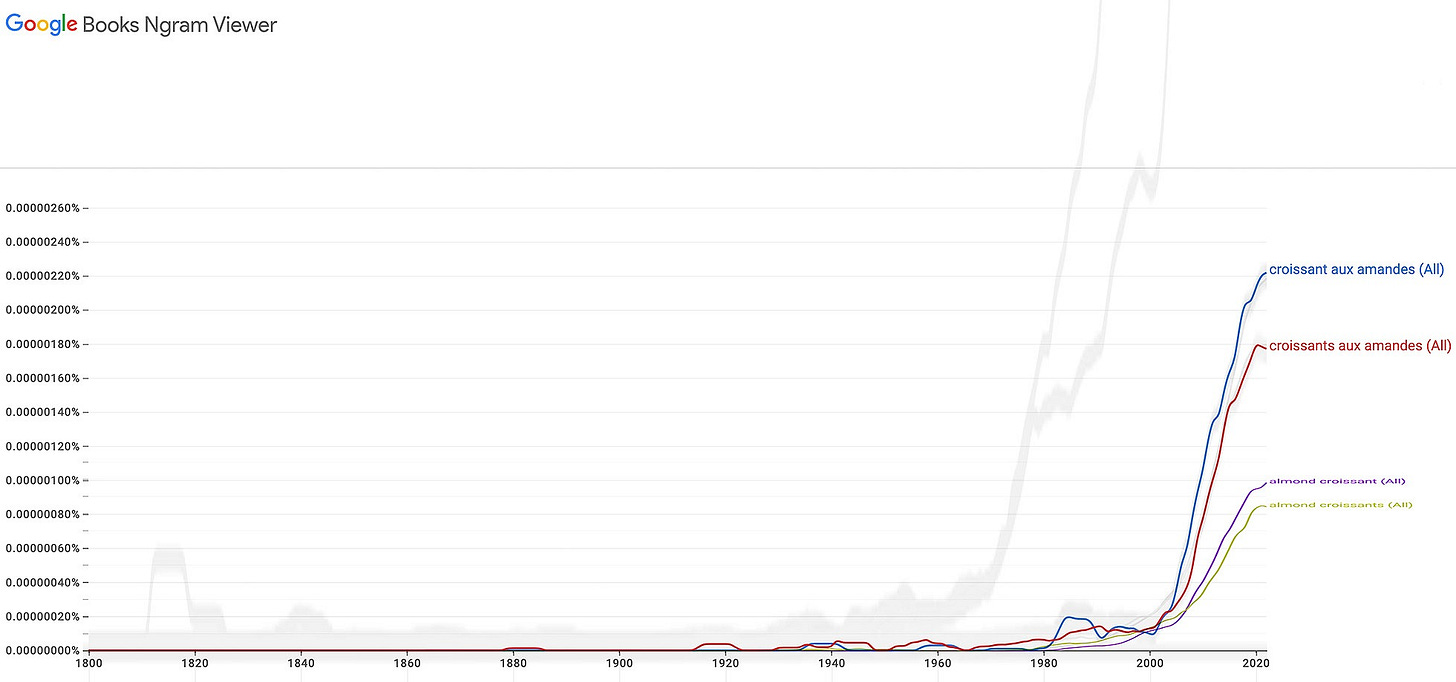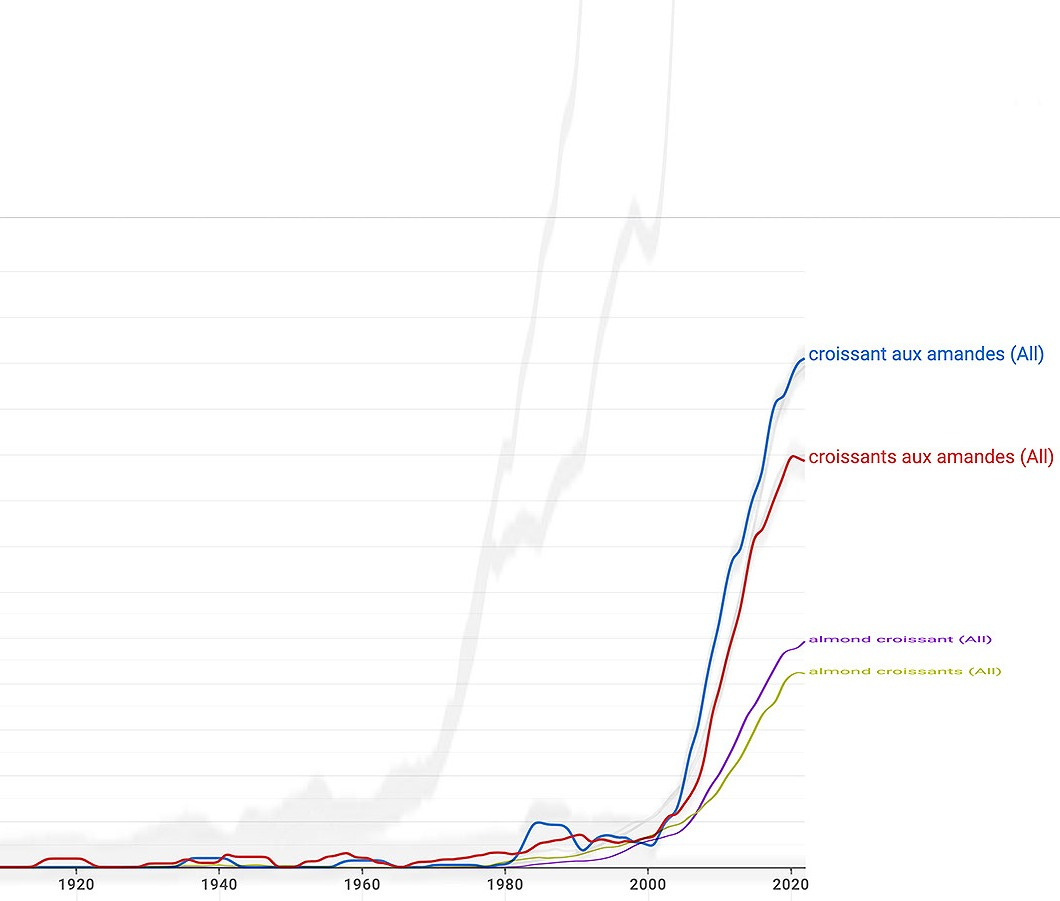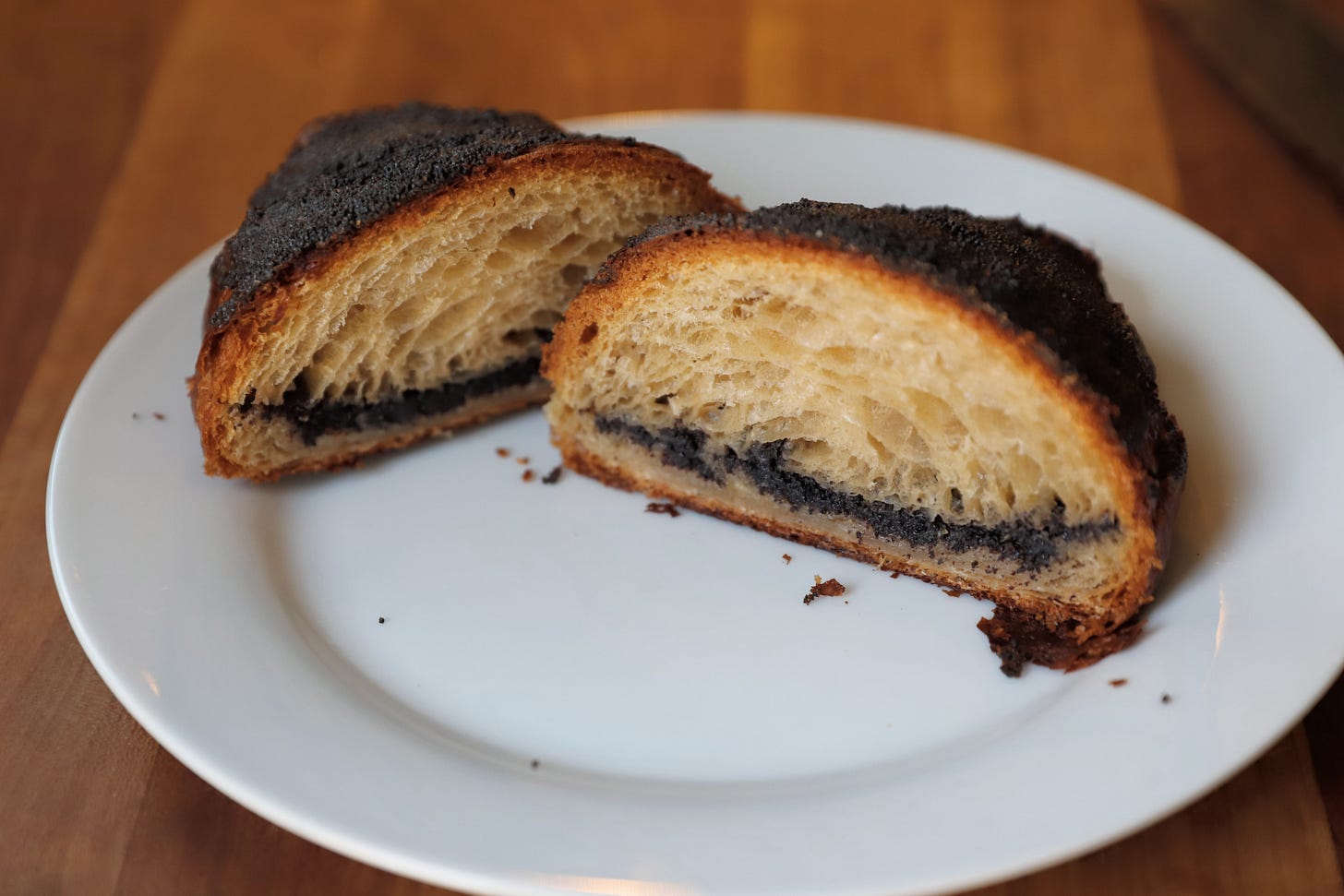Good morning—
If not for
’s seemingly infinite energy for baking — and her apparent mastery of time management, given baking isn’t even her profession — I might never have made poppy seed croissants.When Felicity recently shared that she’d made the Poppy Seed Jam Strudel from my book, I was reminded of how much I love poppy seed pastries, and the idea of a sweet poppy seed croissant set up shop in my piggy brain. The viennoiserie floating in my thought bubble was made just as an almond croissant is (i.e., an existing croissant is doused with a syrup, smeared inside and on top with frangipane and sprinkled with slivered almonds), but with the almonds re-cast as poppy seeds.
A little research on the history of the almond croissant (“croissant aux amandes” in French) was in order. And I imagined I’d be rewarded with straightforward facts: an inventor (or a few, as is often the case), a date (or at least a decade), maybe even the name of a bakery that made the almond croissant famous.
As with most rewarding digging, my search for answers didn’t turn up what I’d expected to find, and it led to more questions, some of which will have to await my attention until I have the time and resources to fly to France to conduct interviews and comb through library documents (read: click that “upgrade subscription” button! 🙏). But for now, the responses I got from French friends via WhatsApp and from the internet-accessible documents I found will have to do.
THE CROISSANT (or THAT WHICH PRECEDED THE ALMOND CROISSANT)
Legend claims the croissant made a royal entrance in France, having been packed in the luggage of Marie Antoinette to make the journey from Austria along with the future queen. But Food historian Jim Chevallier rebuts this romantic account, insisting instead that the proto-croissant was installed in France by Austrian entrepreneurs August Zang and Ernest Schwarzer when they opened their “Boulangerie viennoise” in Paris in the late 1830s. Their hometown lent its name not only to their bakery but eventually to the entire category of baked goods that would come to be known in French as “viennoiseries.”
Though similar in shape and a clear forebear to the modern croissant, neither Marie Antoinette’s nor Zang’s and Schwarzer’s imported “kipfel” bore a signature characteristic we today associate with the French croissant. The flakiness and interior tenderness of the modern croissant is owed to its yeasted laminated dough, or pâte feuilletée. But the first “croissants” in Paris, writes Chevallier, were more of an enriched bread dough, containing eggs and sometimes butter. We only find evidence of the laminated-dough croissant beginning with a 1905 recipe.
THE ALMOND CROISSANT (or THAT WHICH PRECEDED THE POPPY SEED CROISSANT)
Historians have worked out a reasonable timeline for the plain croissant, but when it comes to the adaptations, or déclinaisons, – specifically the almond croissant – well, it appears that a history hasn’t crystallized just yet; My early-2000s edition of the encyclopedic Larousse gastronomique includes a recipe for croissants aux amandes but offers no origin story whatsoever.
So, without a French library and its microfiches at my disposal, I turned to the next-best sources: my French friends and the Google Books Ngram Viewer. I often consult the latter for clues as to when a particular word or phrase gained popularity; In this case, it suggested that “croissant(s) aux amandes” began its steady rise in presence in written French just before 1970 (in the instances in which it sporadically appears before those dates, the phrase, which literally means “almond crescents” invariably refers to crescent-shaped almond cookies) and that its rapid ascent began around 2000 (see Figure 1 below).

Of four friends born in the early 1980s who responded1, all but one recalls almond croissants having always been available at boulangeries in their lifetime. (The biggest shock produced by my enquiry came when I learned that Delphine had never tasted an almond croissant. She since has. Her assessment: “Wow, it’s rich…but I don’t regret it.”) Olivier’s father, a longtime pastry instructor at Lenôtre in Paris, said that he made almond croissants (using day-old croissants) as an apprentice in the 1970s. But broader familiarity with almond croissants – among laypeople -- may have been a decade or so away; a sixty-year-old Parisian friend adamantly insists that almond croissants “did not exist” in Parisian bakeries until the mid-1980s.
THE POPPY SEED CROISSANT (or THAT WHICH PRECEDED MY TYPING THIS)
An almond-croissant-and-poppy-seed storm raged inside me, and I needed a release. I consulted my Larousse gastronomique and
’s and ’s Tartine: A Classic Revisited for reference recipes, adapted the frangipane into a poppy-seed cream and the brandy syrup into a maple-and-lemon liquid. Then I devised a version which, like that poppy seed jam strudel recipe of mine that Felicity made, requires no refined sugars. I include recipes for both versions below.Note: The key to releasing the nutty flavor of poppy seeds is to grind them. It is imperative and must be done with a spice grinder, a clean coffee grinder, or (as I recently learned form
’s Classsic German Baking) a grinder expressly for poppy seeds.Now, for the resulting recipes that gave me exactly what I wanted. . .
RECIPE: POPPY SEED CROISSANTS
Don’t fear; you will not be making croissants from scratch for this recipe! You’ll buy them.
This viennoiserie revives a (preferably) day-old croissant with a sweet poppy seed cream filling (think poppy seed frangipane) and a subtle maple-lemon syrup that caramelizes and, along with extra poppy seeds, crisps up the outer layers of the croissant. At the end of the recipe, you’ll find a fruit-sweetened version of the filling. Seek out high-quality poppy seeds in bulk, such as those from nuts.com or Frontier Co-op.
Yield: 6 poppy seed croissants
Total time: 45 minutes
INGREDIENTS:
Keep reading with a 7-day free trial
Subscribe to Formal Assignment to keep reading this post and get 7 days of free access to the full post archives.







